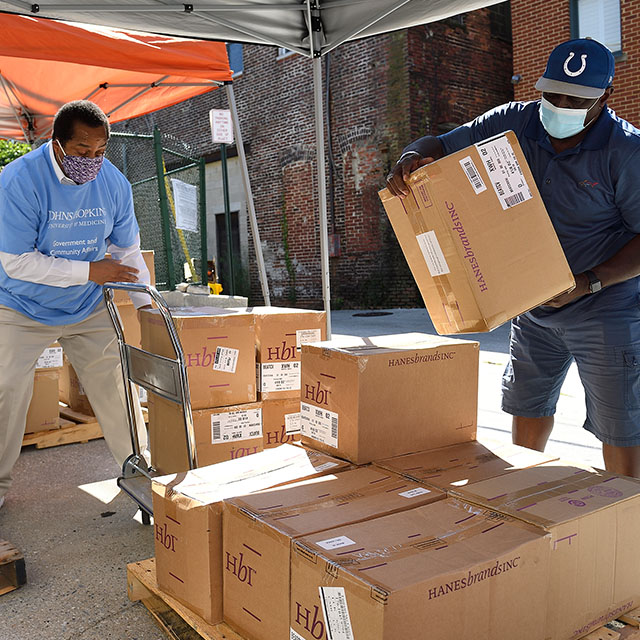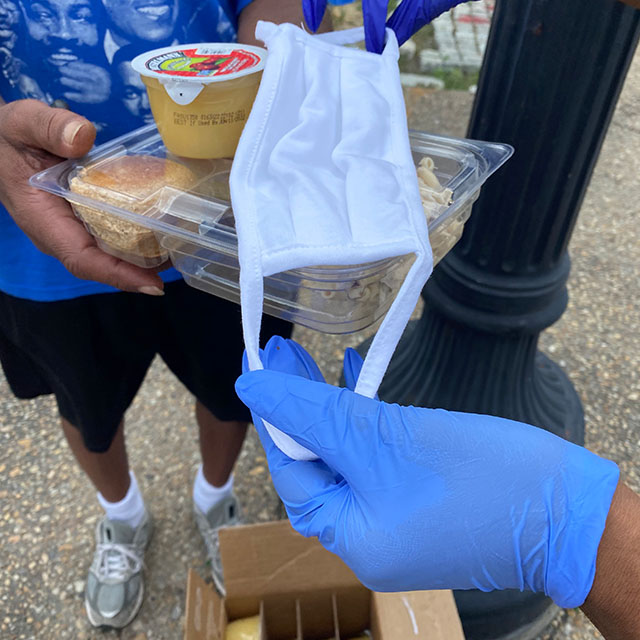Masks. Lockdown. Quarantine. Those are a few of the words that sum up life during the COVID-19 pandemic. However, if you look deeper you’ll also find: Togetherness. Opportunity. Volunteering.
The needs of nonprofits and charities for volunteer assistance have continued unabated during the pandemic, and for many have increased exponentially.
Alicia Wilson is vice president for economic development at The Johns Hopkins University and the Johns Hopkins Health System. Nancy Beck is a nurse educator in the Department of Surgery. Experienced volunteers, they share the following tips for how to be a successful volunteer during this time of public safety restrictions and caution.
- Volunteering in person is possible during COVID-19. Many organizations are taking extra precautions to ensure volunteer safety by screening in-person volunteers for symptoms, checking temperatures, ensuring physical distancing and sanitizing equipment between users. “I do food distribution with a number of groups, packing foods as well as distributing them in the community,” says Wilson. “Those activities have been done in a very physically distant manner while being engaged with other volunteers. I enjoy the physical activity, and I feel very safe doing it.” But trust your gut. If you arrive at a volunteer event and don’t think organizers are sufficiently safeguarding the health of their volunteers, you should leave immediately and let them know you don’t feel safe.
- It’s easy to find volunteer opportunities. “Just go to Catholic Charities of Baltimore or the United Way of Central Maryland websites and you’ll find many places looking for all sorts of help,” says Beck. “That’s how I found out about Our Daily Bread. They feed 500 to 1,000 people every day of the year. Even during COVID-19 they do a daily bagged lunch to go.”
- Location, location, location. “Look for organizations that are in close proximity to you, because there’s nothing like being able to see the fruits of your contribution, whether it be near where you work, where you live, or where you frequent,” says Wilson. “That positive reinforcement sustains your volunteerism.”
- Volunteer to do tasks you enjoy. “Know your limits, and don’t be shy about what you don’t want to do,” says Beck. “Most places have a bunch of different tasks and needs. At Our Daily Bread, the only thing I don’t like doing is washing dishes, so I let people know I don’t want to do that and it’s never been a problem. It’s important that you enjoy the activity, otherwise it won’t be a successful volunteer effort.”
- Follow your passion. “Whenever anyone says they want to volunteer but don’t know what to do, I always ask them what they are passionate about,” says Wilson. “Find what resonates with you, and you will find you are able to engage in sustainable volunteerism. Many people’s efforts today are in response to their former selves. They’re showing up for the child they were and filling that gap that they felt in their lives. That’s their way of giving back and showing appreciation. If it was important to you as a child to have someone read to you, then find a reading program that will pair you with a child in need. Figure out what brings you joy, because that’s what’s going to keep you engaged.”
- Volunteer with a friend. “It can be a little scary the first time if you go to a new place by yourself,” says Beck. “Get a buddy to go with you, and that always makes it easier — and more fun. The places that I’ve volunteered over the years have always been so welcoming and so appreciative of whatever help people can give. You don’t have to ever worry that you’re not going to be welcomed.”
- Opportunities abound at Johns Hopkins. “There’s really no shortage of ways to get engaged, and we also have some great opportunities right here at Johns Hopkins,” says Wilson. “Unlike most employers, we have great organizations within our system that welcome volunteers, like Medicine for the Greater Good, Source, Center for Social Concern and Centro SOL. We have a number of groups that are engaged with the community and provide some great ways to get engaged as well.”
- Start your own volunteer effort. “We were in the middle of COVID-19, and our surgery patients couldn’t have visitors, and they were not having much communication,” says Beck. “Our team started talking and saying, wouldn’t it be nice if we could get our communities to make cards. I took the idea to my neighborhood homeowners association. I said our patients are by themselves and they need cards. I couldn’t believe how many cards I received: get-well cards, Mother’s Day cards, birthday cards. Now, whenever it’s someone’s birthday, they get a card. Kids wrote cards with one-line jokes that are so corny you just have to laugh. It’s great medicine.”
- The demand for virtual volunteerism. Nonprofits are almost always recruiting new board and committee members. If you are not sure which organizations to reach out to, just think of those you are already supporting, such as through a small monthly or annual donation, says Wilson. If you are already supporting an organization financially, then there’s a good chance that organization will be a good fit for you. “There are so many organizations that need your voice at the table, as well as your perspective, your wisdom and your intellect,” says Wilson. “Right now, many organizations would welcome you and your connections. If you don’t have the time to get in there and give your physical time, you can join a Zoom meeting and share your experience and expertise. The blessing of COVID-19 is you can sit on Zoom and give tremendous value to organizations that are trying to think through really, really difficult challenges.”



